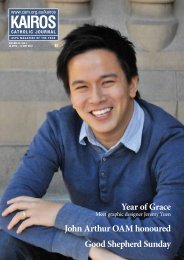Ministering at Mass - Catholic Archdiocese of Melbourne
Ministering at Mass - Catholic Archdiocese of Melbourne
Ministering at Mass - Catholic Archdiocese of Melbourne
Create successful ePaper yourself
Turn your PDF publications into a flip-book with our unique Google optimized e-Paper software.
MusicThe criterion th<strong>at</strong> mustinspire every composition andperformance <strong>of</strong> songs and sacredmusic is the beauty th<strong>at</strong> invitesprayer.John Paul II Address to the PontificalInstitute for Sacred Music for its 90thanniversary, January 19, 2001The church loves singing <strong>at</strong> <strong>Mass</strong>! Singing is “the sign <strong>of</strong> the heart’sjoy” (cf. Acts 2:46). The cantor and choir help the people to pray,recognising th<strong>at</strong> the primary choir <strong>of</strong> the liturgy is the g<strong>at</strong>heredassembly itself.Wh<strong>at</strong> kind <strong>of</strong> music is suitable for <strong>Mass</strong>?Music for <strong>Mass</strong> should be reverent, dignified and evoke prayer.Gregorian chant and polyphony have a special place in thechurch’s liturgy, but contemporary sacred and liturgical musicis also permitted if it can be made suitable for use in worship.The Australian C<strong>at</strong>holic Bishops Conference has a list <strong>of</strong> songsrecommended for <strong>Mass</strong> (see additional resources below); it’s agood idea to give any song selections outside this list to your priestto review.A note about instruments: the voice is the primary instrumentin the liturgy. Instruments should be used to support voices, andnot drown them out! The organ has a special place because it cansustain the singing <strong>of</strong> a large assembly, but other instrumentscan also be used if they are suitable for sacred worship (GIRM393). Again, check with your priest about the instruments you areconsidering using during <strong>Mass</strong>.How much singing?Depending on the solemnity <strong>of</strong> the occasion (the significance <strong>of</strong>the feast to be celebr<strong>at</strong>ed), it is not always necessary to sing all theparts <strong>of</strong> the <strong>Mass</strong> th<strong>at</strong> can be sung. Preference is given to singingparts <strong>of</strong> the <strong>Mass</strong> which are more important: ministerial chants, theGospel Acclam<strong>at</strong>ion, Sanctus, Memorial Acclam<strong>at</strong>ion and the Gre<strong>at</strong>Amen are encouraged to be sung even without accompanimentfrom instruments. The Psalms, which were originally written assongs, should also be sung where possible.Some tips• Design<strong>at</strong>e a leader to guide the choir and instrumentalistsduring the <strong>Mass</strong>. They should be able to signal to themusicians when to begin and stop according to wh<strong>at</strong>’shappening, keep everyone in balance, and make sure th<strong>at</strong> themusic is helping the people to pray.• <strong>Mass</strong> settings set music for the different parts <strong>of</strong> the <strong>Mass</strong>.There are many available. Make sure you pick one which is inline with the New Transl<strong>at</strong>ion <strong>of</strong> the Roman Missal (anythingpublished pre-2010 won’t do!) and try to ensure th<strong>at</strong> excerptsfrom different settings help to unify the prayer. Each settinghas a musical uniformity th<strong>at</strong> helps the congreg<strong>at</strong>ion learn themusic and feel confident joining in.4• Be faithful to the missal and the lectionary. Don’t replacethe Responsorial Psalm with a song or get cre<strong>at</strong>ive with thewords <strong>of</strong> the <strong>Mass</strong> parts. Unauthorised omissions or editorialchanges are not permitted. (See Sacrosanctum concilium(1963), 22.3)



